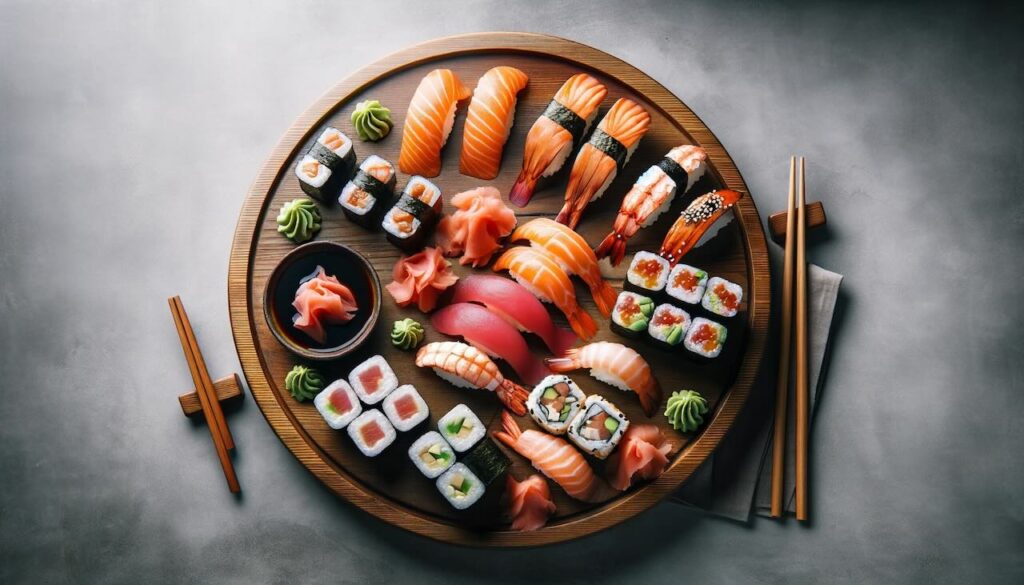Few dishes embody the spirit of Japanese cuisine as elegantly as sushi. A symbol of simplicity, precision, and creativity, sushi has traveled a long and fascinating road—from its origins as a method of food preservation to its current status as a global gastronomic phenomenon.
Let’s dive into the story of sushi: how it began, how it transformed through the centuries, and how it continues to evolve today.
- Ancient Beginnings: Preserving Fish with Rice
- The Kamakura Innovation: Hayanarezushi
- The Edo Period: Birth of Nigiri and Modern Sushi
- Expansion Across Japan: Meiji and Taishō Periods
- A Postwar Revival: Sushi as a Symbol of National Identity
- Sushi Goes Global
- Contemporary Sushi: Innovation Meets Heritage
- Conclusion: A Dish That Transcends Borders
Ancient Beginnings: Preserving Fish with Rice
The earliest form of sushi, known as narezushi, originated in Southeast Asia as a means to preserve fish. This technique, which involved fermenting fish with rice, made its way to Japan via China. In this early form, the rice was discarded, and only the fermented fish was eaten.
By the Nara period (710–794), the word “sushi” appeared in Japanese texts like the Kojiki and Engishiki, signaling that this preservation technique had already been woven into Japanese culinary practices—particularly at the imperial court.
The Kamakura Innovation: Hayanarezushi
Fast-forward to the Kamakura period (1185–1333), when a major evolution occurred: hayanarezushi, or “quick-fermented sushi.” By adding vinegar to the rice, the fermentation process was accelerated, allowing both rice and fish to be consumed together within a few days. This pivotal development marked sushi’s transformation from a preservation technique into a flavorful, ready-to-eat dish.
The Edo Period: Birth of Nigiri and Modern Sushi
Sushi took its most dramatic leap during the Edo period (1603–1868) in what is now Tokyo. With bustling urban centers and fast-paced lifestyles, food vendors developed Edo-mae sushi—fresh slices of seafood placed atop vinegared rice, served quickly from street stalls.
Enter Hanaya Yohei, the culinary innovator often credited with creating nigiri-zushi. His style of hand-pressed sushi became the prototype for what we recognize as modern sushi: elegant, efficient, and full of umami. Nigiri was a perfect fit for Edo’s vibrant street food culture and became a staple for the city’s working class.
Expansion Across Japan: Meiji and Taishō Periods
The Meiji Restoration (1868–1912) marked Japan’s rapid modernization. As transportation networks grew, so did sushi’s reach—from Edo to cities and towns across the country. Refrigeration and shipping innovations made it possible to serve fresh fish even far from the coast, and sushi restaurants began to multiply.
By the Taishō period (1912–1926), sushi was no longer regional—it had become a beloved national dish.
A Postwar Revival: Sushi as a Symbol of National Identity
After World War II, Japan entered a period of economic recovery and growth. Sushi reemerged not just as an everyday meal but as a refined, cultural staple, enjoyed in both formal restaurants and casual eateries.
One of the most significant developments came in the 1950s with the invention of kaiten-zushi (conveyor belt sushi) by Yoshiaki Shiraishi. This innovation revolutionized dining by making sushi affordable, quick, and accessible, especially for families and busy urban workers.
Sushi Goes Global
In the 1970s, sushi crossed the Pacific and began its international ascent. In the United States, creative adaptations like the California roll and spicy tuna roll introduced sushi to new audiences through familiar flavors and ingredients.
By the 1980s and 1990s, sushi restaurants had opened in major cities across Europe, North America, and beyond. Once considered exotic, sushi became part of the global mainstream.
Today, sushi can be found everywhere—from Michelin-starred omakase counters to supermarket shelves—each reflecting regional interpretations and culinary innovation.
Contemporary Sushi: Innovation Meets Heritage
As sushi continues to evolve, chefs around the world experiment with:
- Creative rolls that blend global flavors
- Plant-based and vegan options that reimagine traditional ingredients
- Sustainable practices, including eco-friendly sourcing and seasonal menus
And yet, the soul of sushi remains intact. Its core values—balance, harmony, seasonality, and respect for ingredients—are still at the heart of every perfectly formed piece.
Conclusion: A Dish That Transcends Borders
From its ancient origins in fermented preservation to its status as an international symbol of culinary art, sushi represents Japan’s unique ability to blend tradition with innovation. It is a dish that speaks to the eye, the palate, and the spirit—reflecting not just what’s on the plate, but the culture, history, and values of a nation.
As sushi continues to inspire chefs and diners around the globe, it stands as one of Japan’s most treasured gifts to the world—timeless, evolving, and universally loved.


